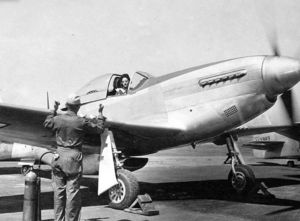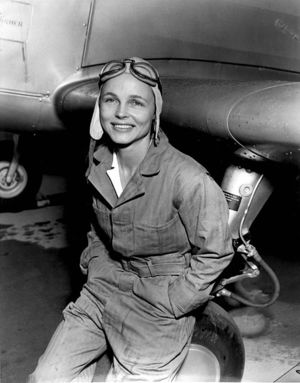- Profile
- Images
Location: [unknown]

|
| WASP Wings |

|
| American Campaign Medal |

|
| WWII Victory Medal |
"As long as our planes fly overhead the skies of America are free and that's what all of us everywhere are fighting for. And that we, in a very small way, are being allowed to help keep that sky free is the most beautiful thing I have ever known.
I, for one, am profoundly grateful that my one talent, my only knowledge, flying, happens to be of use to my country when it is needed. That's all the luck I ever hope to have."
~Cornelia Fort
"This is not a time when women should be patient. We are in a war and we need to fight it with all our ability and ever weapon possible. Women pilots, in this particular case, are a weapon waiting to be used."
~Eleanor Roosevelt

|
Jackie Cochran requested she be allowed to establish a training program to recruit and train women for flying duties. On September 14, 1942, General Henry Arnold, Commanding General of the Army Air Forces, approved the Women's Flying Detachment. The 23 week training program, placed under the direction of Cochran, was based out of Houston. Jackie's goal was to prove that any healthy, stable young American woman could learn to fly just as well as any man. The first batch of applications was sent to 150 women, 130 of whom responded immediately. Each was personally interviewed by Cochran. 30 were selected for the first class and notified by telegram to report to Houston at their own expense.

|
In September of 1942, Nancy Love was appointed as the director of the Women’s Auxiliary Ferrying Squadron (WAFS) under Maj. Tunner and given a chance to prove her skeptics wrong. Nancy initially sent telegrams out to 83 of America’s best women pilots recruiting them as civilian pilots to serve in the Ferry Command. The women had to be between 21 and 35 years of age, logged at least 500 hours in the air, hold a commercial license, a 200-horsepower engine rating, and have recent cross-country flying experience. Twenty-eight women met these rigorous standards and answered the call to serve their country during wartime in the Air Transport Command. Stationed at New Castle Army Air Base, these twenty-eight highly qualified, elite civilian women pilots, “The Originals” as they would come to call themselves, began ferrying light aircraft and primary trainers such as Stearmans and PT-19 Fairchilds. They quickly went on to ferry larger aircraft including pursuit planes like the P-38 and P-51.
The 28 Original WAFS
Nancy Batson, Bernice Batten, Kathryn Bernheim, Delphine Bohn, Phyllis Burchfield, Helen Clark, Barbara Donahue, B.J. Erickson, Opal Ferguson, Cornelia Fort, Dorothy Fulton, Betty Gillies, Teresa James, Nancy Love, Ester Manning, Lenore McElroy, Helen McGilvery, Gertrude Meserve, Florene Miller, Esther Nelson, Barbara Poole, Aline Rhonie, Helen Richards, Alda Scharr, Dorothy Scott, Evelyn Sharp, Katherine Thompson and Barbara Towne.
WASP Timeline
1939
- June – The Civilian Pilot Training Program (CPTP) is established by the US government. The program is provided pilot training across the country and allowed for one woman to be trained for every ten men.
- September 1 – Germany invades Poland.
- September 3 – France and Great Britain declare war on Germany.
1940
- September 28 – Jackie Cochran writes to First Lady Eleanor Roosevelt suggesting the establishment of a women’s flying division of the Army Air Forces whereby women could perform jobs releasing men to fly combat.
1941
- June – Jackie Cochran becomes the first woman to ferry a bomber across the Atlantic.
- June – Women are banned from participating in the Civilian Pilot Training Program.
- December 7 – Japan attacks the US fleet at Pearl Harbor.
1942
- March – Jackie Cochran takes 25 American women pilots to Britain to fly with the British Air Transport Auxiliary.
- September – Following a proposal submitted by pilot Nancy Harkness Love to the Ferry Command of the Army Air Forces, the Women’s Auxiliary Ferrying Squadron, or WAFS, is established. America’s top women pilots will soon begin ferrying aircraft throughout the US.
- September 15 – Jackie Cochran establishes the Women’s Flying Training Detachment (WFTD) under General Henry Arnold, chief of the Army Air Forces.
- November 17 – The first class of 28 recruits from the Women’s Flying Training Detachment reports to Houston, Texas, municipal airport.
- November – The WAFS fly their first mission, taking Piper Cubs from Lock Haven, Pennsylvania, to Mitchell Field, New York.
1943
- February 6 – The WFTD increases its goal for the number of women pilots to graduate that year from 396 to 750.
- February 21 – Avenger Field in Sweetwater, Texas, welcomes its first class of women pilots.
- February – The WFTD school in Houston, Texas, closes.
- August 5 – The Women’s Auxiliary Ferrying Squadron (WAFS) merge with Jackie Cochran’s training program to form the Women Airforce Service Pilots (WASP).
- September 30 – Representative John Costello of California introduces the WASP militarization bill.
- December 17 – The WASP wings are made available in time for the graduation of Class 43-W-8.
1944
- February – The WASP are issued the Santiago Blue uniform.
- March 24 – Senators Joseph Hill, of Alabama, and Harold Burton, of Ohio, submit a resolution calling for the appointment of female pilots and aviation cadets for the Army Air Forces.
- May 29 – Time magazine runs an article entitled “Unnecessary and Undesirable” calling the WASP experiment expensive and claims men could have been trained more quickly.
- June – The Congressional bid for WASP militarization fails. It was the first time during World War II that legislation supported by the Army Air Forces was voted down.
- July – Rumors begin circulating in the press that the WASP program is about to be disbanded.
- October 1 – General Arnold issues a memorandum to WASP Director Jackie Cochran stating that because of the changing war situation the WASP would “soon become pilot material in excess of needs.”
- October – The WASP receive notification from WASP Director Jackie Cochran and General Arnold that their unit would be disbanded in December.
- November 1 – Brigadier General Bob Nowland writes a memo describing the hardships that will be caused by deactivating the WASP program.
- December 7 – General Arnold addresses the final graduating class of WASP.
- December 20 – The WASP program is official disbanded.
1977
- October 19 – The Senate votes unanimously to grant WASP veterans’ recognition.
- November 3 – The House votes to give the WASP veteran status.
- November 23 – President Jimmy Carter signs a bill into law “Officially declaring the Women Airforce Service Pilots as having served on active duty in the Armed Forces of the United States for purposes of laws administered by the Veterans Administration.”
1979
- March 8 – The Department of the Air Force authorizes official discharges for the WASP.
- May – The Air Force issues the first honorable discharges for women serving in the WASP during the Second World War.
2009
- July 1- President Barrack Obama and the United States Congress awarded the WASP the Congressional Gold Medal.
The 38 WAFS/WASP who were Killed in Service to their Country
Thirty-eight WAFS/WASP fliers lost their lives while serving during the war, all in accidents. Eleven died in training and twenty-seven on active duty. Because they were not considered military under the existing guidelines, a fallen WASP was sent home at family expense without traditional military honors or note of heroism. The army would not allow the U.S. flag to be placed on the coffin of the fallen WASP.
- ~Jane Champlin, June 7, 1943, Sweetwater, Texas.
- ~Susan P Clarke, July 4, 1944, Columbia, South Carolina.
- ~Margie L Davis, Oct 16, 1944, Walnut, Mississippi.
- ~Katherine Dussaq, Nov 26, 1944, New Carlisle, Ohio.
- ~Marjorie Edwards, June 13, 1944, Childress, Texas.
- ~Elizabeth Erickson, April 16, 1944, Sweetwater, Texas.
- ~Cornelia Fort, Mar 21, 1943, Abilene, Texas.
- ~Frances Grimes, Mar 27, 1944, Otis Field, Massachusetts.
- ~Mary Hartson, Aug 14, 1944, Sherman, Texas.
- ~Mary H Howson, April 16, 1944, Sweetwater, Texas.
- ~Edith Keene, April 25, 1944, Mission, Texas.
- ~Kathryn B Lawrence, Aug 4, 1943, Sweetwater, Texas.
- ~Hazel Ying Lee, Nov 23, 1944, Great Falls, Montana.
- ~Paula Loop, July 7, 1944, Medford, Oregon.
- ~Alice Lovejoy, Sept 13, 1944, Brownsville, Texas.
- ~Lee Ola McDonald, June 21, 1944, El Paso, Texas.
- ~Peggy Martin, Oct 3, 1944, Marana, Arizona.
- ~Virginia Moffatt, Oct 5, 1943, Ontario, California.
- ~Beverly Moses, July 18, 1944, Las Vegas, Nevada.
- ~Dorothy Nichols, June 11, 1944, Bismarck, North Dakota.
- ~Jeanne L Norbeck, Oct 16, 1944, Shaw Field, South Carolina.
- ~Margaret Oldenburg, Mar 7, 1943, Houston, Texas.
- ~Mabel Rawlinson, Aug 23, 1943, Camp Davis, North Carolina.
- ~Gleanna Roberts, June 20, 1944, Lorraine, Texas.
- ~Maria Robinson, Oct 2, 1944, Victorville, California.
- ~Betty Scott, July 8, 1944, Waco, Texas.
- ~Dorothy Scott, Dec 3, 1943, Palm Springs, California.
- ~Margaret Seip, Aug 30, 1943, Big Spring, Texas.
- ~Helen J Severson, Aug 30, 1943, Big Spring, Texas.
- ~Ethel M Sharon, April 10, 1944, Tecumseh, Nebraska.
- ~Evelyn Sharp, April 3, 1944, New Cumberland, Pennsylvania.
- ~Gertrude Silver, Oct 26, 1944, Southern California.
- ~Betty P Stine, Feb 25, 1944, Tucson, Arizona.
- ~Marion Toevs, Feb 18, 1944, San Jose, California.
- ~Mary E Trebing, Nov 7, 1943, Blanchard, Oklahoma.
- ~Mary L Webster, Dec 9, 1944, Claremore, Oklahoma.
- ~Bonnie Jean Welz, June 29, 1944, Randado, Texas.
https://mail.google.com/mail/?shva=1#inbox
- ~Betty L Wood, Sept 23, 1943, Camp Davis, North Carolina.
Source
- Women with Silver Wings Zackman, Gaba, audio. by Katherine Sharp Landdeck, read by Gabra Zackman (online: SoundCloud) Five minute audio from the book. ~45 minutes.
- Login to request to the join the Trusted List so that you can edit and add images.
- Private Messages: Contact the Profile Managers privately: Paula J, Mary Richardson, Terry Wright, and Bill Sekel. (Best when privacy is an issue.)
- Public Comments: Login to post. (Best for messages specifically directed to those editing this profile. Limit 20 per day.)
- Public Q&A: These will appear above and in the Genealogist-to-Genealogist (G2G) Forum. (Best for anything directed to the wider genealogy community.)









edited by Mary Gossage
Also, I created a profile for one of the women: Frances Grimes. Could you link to her from the text? Her name is listed in the 38 WAFS/WASP who were Killed in Service to their Country section. Thanks!
Natalie
edited by Natalie (Durbin) Trott